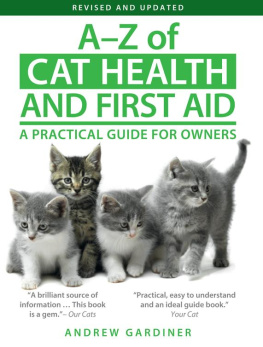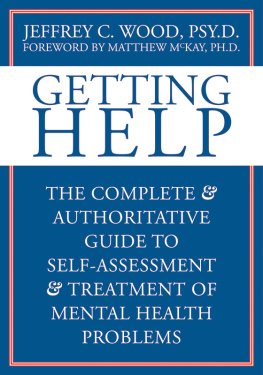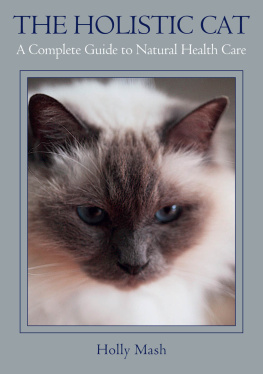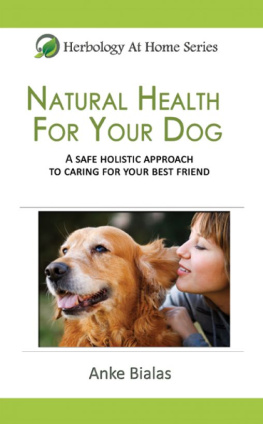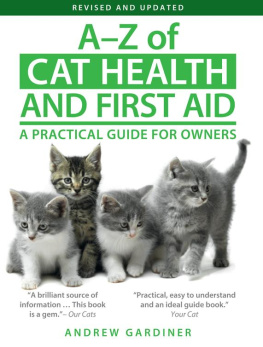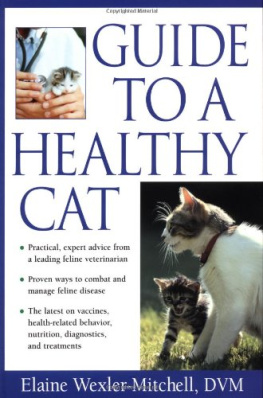In memory of my mother, Maisie Gardiner
No book can replace the services of a trained veterinarian. This book is not intended to encourage treatment of illness, disease, or other medical problems by the layman. Any application of the recommendations set forth in the following pages is solely at the readers discretion and risk. You should consult a veterinarian concerning any veterinary medical or surgical problem. If a veterinarian is caring for your pet, for any condition, he or she can advise you about information described in this book.
Contents
There is a saying, You own a dog, but you feed a cat.
I think this sums up quite well the intriguing nature of the relationship we have with cats. Somehow, we can never possibly own them in the same way as we may think we own pet dogs cats are far too independent, far too aloof for all that. Instead, cats may choose to share their lives with us or, just possibly, move on elsewhere if circumstances are not to their liking! Quite a large percentage of the life of a pet cat often takes place outside the home, a whole complex web of usually nocturnal activities and routines of which owners are blissfully unaware.
Most cat owners say that it is this quality of independence, mystery and resourcefulness that they find most appealing about their pets. This as well as all their individual quirks and habits of course. They are, in many ways, the ideal pet for people who do not have the time, space or energy to devote to a dog, or for those who seek out the spiritual side of life, because cats have always signified that.
My own experience of cats comes from those I have lived with, and of course from the very many cats I have treated as a veterinary surgeon. I find cats almost as varied and complex as people there is the full spectrum of personalities present, from the enormous placid lumps of feline contentment to the sleek, nervy spitfires that seem to say, Look at me in the wrong way and Ill fly!
Any vet will tell you that cats can be awkward patients. For one thing, their dignity is lost, and their instincts, too, can be harmful. A sick dog may seek out reassurance and response from its pack-leader owner; a sick cat may be bad tempered and irritable or may crawl under a shed to sit the illness out (or, always the worry, get progressively worse). The independence and even remoteness that we value in healthy cats can become a problem when they are not well, making feline medicine and treatment quite different from its canine counterpart.
This book, I hope, will allow owners to understand their cats well-being better. A thorough reading of its contents will give the interested owner a good insight into cat health and behaviour, and allow the most effective nursing and first aid to be supplied to the patient under veterinary care. It should also be of value to those involved in cat rescue and welfare work, whether in this country or abroad, and the first aid sections will be especially useful when professional veterinary care is not readily available in these situations.
Andrew Gardiner, Edinburgh, UK
I would like to thank Ernest Hecht and his colleagues at Souvenir Press for their help on this book. Illustrator Jay Pressnells cat acted as a model for most of the cat drawings and my own cat was persuaded, with some difficulty, to pose for a few photographs. Other pictures come from cats I have treated, mainly at the Blue Cross and PDSA, and on various Greek islands when doing welfare work for the Greek Cat Welfare Society.
A. G.
January 2015
Please do not use this book as an alternative to seeking professional veterinary advice! It is intended to complement and expand on that, but not replace it. Although I have tried to write the book in such a way that the complex nature of cat diseases is understandable, medicine (and cats) are too unpredictable to be able to cover every conceivable situation. Vets study for years to understand animal diseases, and even then the task is often far from easy, so never rely entirely on any book, magazine article, web page or story from another owner who managed to cure their own cat of exactly the same thing using such-and-such a treatment. Its not worth the risk.
Do, however, use the book as a way of understanding your cat and its illness or injury better. Use it to ask questions of your veterinary surgeon or nurse about anything you dont understand concerning the treatment they are proposing they will be happy to explain. If they are not, then find professionals who will! Try to bear in mind that an animal is much more complex than a machine. Diagnosis is not always easy; misleading or confusing results can be given even after extensive tests that is in the nature of medicine and treatment, whether human or animal. Vets are denied the opportunity to have their patients explain their problems directly much of what is relied upon comes from the owner, and this may not always be totally accurate. However, by reading and using this book, your own accuracy in describing symptoms and making observations is likely to be improved, and your cats recovery helped as a result.
For ease of use, the book is arranged alphabetically according to diseases, symptoms or injuries. Many cat problems can be known by more than one name or might be found in the book in different ways. For example, when considering a cat that seems to be having problems passing urine, some owners might think to flick to the section on straining, whereas others might decide to turn turn to cystitis initially. Cross-references within the book have been made to try to ensure you are always directed towards every appropriate section. Inevitably, this means that there is occasionally slight repetition between closely related sections but this is necessary to ensure that important information is not inadvertently skipped.
For every condition mentioned, an indication of the relative urgency has also been given this is so that professional treatment for potentially serious problems is not unnecessarily delayed.
Practical first aid
There are lots of hints throughout this book regarding how you can help your cat with home first aid and nursing, both before and after diagnosis. These techniques have been found helpful in day-to-day use, and largely use equipment and materials that are easily to hand. The Introduction also contains very useful general information on nursing sick cats and suggested items for a practical first aid kit are also given. With these things to hand, helpful first aid will be able to be started for most problems likely to be encountered with your cat.
The comments on complementary medicine in the Introduction are not intended to replace the services of a qualified veterinarian but, as the term suggests, to complement professional advice. There are many approaches to diagnosis and treatment; good communication between you and your vet should ensure one that you and your cat are happy with.
When confronted with illness or injury in a pet cat, feelings of uncertainty, helplessness or even panic are often experienced. Suddenly, your familiar pet, usually so confident, outgoing and independent, is behaving abnormally not the cat you are used to at all. She may be withdrawn, unresponsive to the usual things, refusing to have anything to do with food or human attention, maybe her facial expression even looks unusual. She seems to have become a different animal altogether.

